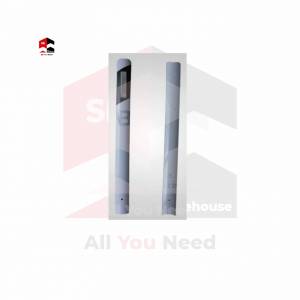Showing the single result
Best Delineator Post Supplier in Malaysia
Asia Warehouse is proud to be recognized as Malaysia’s top delineator post supplier. Our unwavering dedication to excellence, dependability, and customer satisfaction distinguishes us from the competition. We provide many premium delineator posts that enhance road safety and visibility. Whether your project necessitates delineator posts for highways, construction sites, or any other purpose, we comprehensively cover you. Visit our product catalogue to review our delineator posts now.
Frequently Asked Questions Regarding Delineator Post
What is a delineator post?
A delineator post is a high-visibility traffic management tool that enhances clarity and safety during road work or hazardous conditions. These flexible vertical markers, resembling elongated traffic cones, are strategically placed to delineate traffic flow changes, alert drivers to unexpected road features, and guide them through potentially confusing areas. Their bright colours and reflective striping ensured conspicuousness, contributing to improved driver awareness and reduced accident risk.
What does a delineator do?
A delineator is a visual guide for drivers, helping them safely navigate hazards or unusual road conditions. Imagine them like brightly coloured, flexible signposts. They typically do three main things:
- Direct traffic flow: By forming lines or channels, they guide drivers along the intended path, keeping them away from closed lanes or obstacles.
- Alert drivers to dangers: Their bright colours and reflective strips grab drivers’ attention, warning them of upcoming hazards like lane shifts, construction zones, or uneven surfaces.
- Increase visibility: Especially in low-light conditions or bad weather, their reflective properties make them highly visible, guiding drivers even when road markings are hard to see.
What is the difference between a bollard and a delineator?
Delineators and bollards, though both used in traffic management, have distinct roles:
Delineators:
- Function: Guide and inform drivers, not physically block traffic.
- Appearance:
- Typically flexible, slender posts made of plastic or rubber.
- Often striped with highly reflective bands in orange, white, or yellow colours.
- Sometimes topped with reflective discs or flags for extra excellent visibility.
- Placement:
- Used to mark lane changes, construction zones, curves, or other dangerous areas where drivers need clear guidance.
- Often spaced closely together to form a continuous line.
Bollards:
- Function: Physically block or restrict traffic flow.
- Appearance:
- Can be rigid or flexible, but generally sturdier and thicker than delineators.
- Made of various materials like steel, concrete, or plastic.
- Can be fixed in place or removable.
- Placement:
- Used to create barriers or protect specific areas, such as pedestrian walkways, bike lanes, or building entrances.
- Sometimes used to control crowds or to prevent unauthorized access.
What are the different types of delineators?
While numerous variations are based on design and purpose, there are five main types of delineators:
- Flat Panel Delineators: These rectangular, blade-like markers are the most common type. Usually brightly coloured (orange, white, yellow) with reflective stripes, they’re positioned in lines or channels to guide traffic flow.
- Open-Top Delineators: Similar to flat panels, these have an open top for added flexibility and wind resistance. They’re often used in windy areas or near bridges where high gusts could topple regular panels.
- Channelizing Delineators: Featuring angled panels on a single post, these create V-shaped formations to direct traffic around obstacles or through lane changes. Their design ensures that drivers understand the intended flow with just a glance.
- Flexible Traffic Delineators: These bendable posts withstand vehicle impact without damage, making them ideal for construction zones or areas prone to accidental contact. Their flexibility also helps them stay upright in strong winds.
- Stackable Delineators: Designed for easy storage and transport, these feature interlocking bases that allow several units to be stacked vertically. This saves space and makes them convenient for temporary deployments.
What is the height of a delineator post?
In Malaysia, delineator post heights can vary based on the type and application but generally fall between 900mm (35.4 inches) and 1500mm (59 inches). The most common standard height for flexible delineators used in traffic control is 1200mm (47.2 inches) with a weight of around 8kg (17.6 pounds), while taller options like 1500mm are sometimes used for improved visibility in specific situations.

